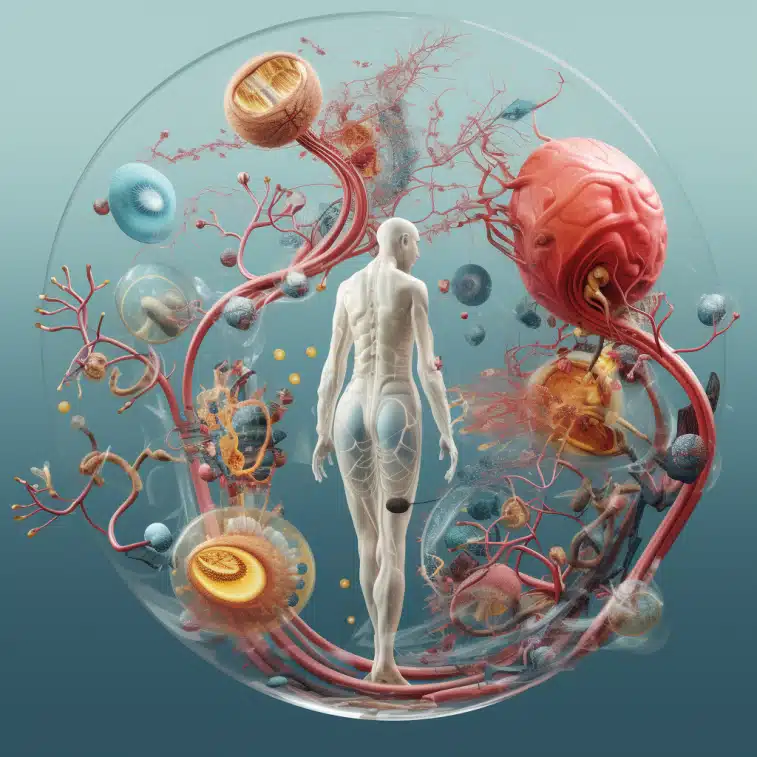The naturally occurring peptide BPC 157 shows potential to treat stroke, schizophrenia symptoms, and spinal cord injury in animal models.
Key facts:
- BPC 157 rapidly counteracted stroke damage and led to full recovery of memory, coordination and movement in rats.
- The peptide alleviated schizophrenia-like symptoms and catalepsy in rodent models by modulating dopamine, glutamate and nitric oxide.
- A single dose of BPC 157 enabled rats with spinal cord injury to regain tail function and prevented paralysis long-term.
- No toxicity has been demonstrated despite wide-ranging benefits of BPC 157 throughout the body in preclinical studies.
Source: Neural Regen Res (2022)
BPC-157 & the Central Nervous System (CNS)
Traumatic injuries and dysfunction in the central nervous system (CNS) remain extremely challenging to treat effectively.
Despite decades of research, there are no robust regenerative therapies to heal damage from stroke, reverse paralysis from spinal cord injury or adequately manage psychiatric conditions like schizophrenia.
A growing body of evidence suggests that BPC 157, a tiny protein fragment discovered in human gastric juice, could offer a completely new therapeutic avenue for treating CNS disorders.
So far, preclinical trials with BPC 157 have demonstrated unprecedented benefits throughout the body, from healing bone fractures to reducing muscle wasting in cancer cachexia models.
Critically, BPC 157 also appears to foster regeneration in the brain, spinal cord and peripheral nerves.
BPC-157 for Reversing Stroke Damage in the Brain
- In a rat model of stroke caused by obstructed blood flow to the brain, BPC 157 rapidly counteracted neurological damage when administered after the blockage was removed.
- All rats treated with BPC 157 regained normal movement and coordination, while untreated animals continued displaying deficits.
- BPC 157 also reversed memory impairment and navigation disabilities assessed in a water maze task.
- The peptide likely achieves these effects by enhancing blood vessel growth and increasing production of nitric oxide, a signaling molecule involved in neural development and plasticity.
- Administration of BPC 157 changed expression of several genes in the hippocampus to protect brain cells from harmful inflammation and oxidative stress.
- This research builds on past studies showing that BPC 157 could treat brain lesions and seizures induced by various chemical insults.
Together these findings indicate exceptional potential of BPC 157 therapy to foster healing and regeneration of brain tissue compromised by stroke or similar ischemia-reperfusion events.
The ability to rescue memory and learned behaviors is particularly remarkable.
While follow-up studies are still needed, BPC 157 may offer a completely new strategy for enabling stroke recovery well beyond the capabilities of current treatments.
BPC-157 for Psychiatric Disorders
In addition to protecting brain cells from physical trauma, BPC 157 appears to modulate key signaling molecules implicated in psychiatric diseases:
- BPC 157 alleviated behavioral deficits in rodent models related to schizophrenia, including some induced by NMDA receptor blockade.
- It counteracted movement abnormalities resembling catalepsy caused by a standard antipsychotic (haloperidol) or nitric oxide synthase inhibitor.
- These effects likely stem from interactions between BPC 157 and dopamine, glutamate and nitric oxide pathways.
- BPC 157 was previously found to offset brain cellular damage in models of Parkinson’s disease, regulate serotonin system function and have antidepressant-like effects.
Together this growing evidence indicates BPC 157 can improve neurological function in diverse rat models of psychiatric symptoms.
The findings resonate with past research on alcohol, painkiller and sedative drugs strongly neutralized by BPC 157.
Altogether they suggest that augmenting or restoring dopamine, glutamate and nitric oxide signaling could treat psychotic disorders.
If replicated in further studies, BPC 157 therapy would provide an easily administered and benign alternative to current antipsychotic medications burdened with metabolic and cardiac side effects.
BPC-157 for Spinal Cord Injury Recovery
In a rodent model that compresses the sacral spinal cord to induce lasting paralysis of the tail, a single dose of BPC 157 produced remarkable functional regeneration:
- BPC 157 injection 10 minutes after injury counteracted tail paralysis within several weeks.
- The treated rats regained normal tail movement and sensory responses that persisted for at least a year of follow-up tests.
- In contrast, untreated rats had permanent tail paralysis and sensory loss with spinal abnormalities still detectable after 12 months.
- BPC 157 likely achieves these regenerative effects through diverse mechanisms – curbing inflammation, cell oxidation and necrosis while activating cell survival signals and growth pathways.
This spinal cord compression injury study adds to substantial literature on the peptide strongly protecting peripheral nerves and recovering neuromuscular function after damage.
The findings suggest major promise for BPC 157 therapy to foster axon regeneration and functional rescue in human patients paralyzed by spinal cord injury.
Additional trials are warranted to explore optimal dosage, timing and combination treatment regimens.
BPC-157’s Safety Profile & Therapeutic Potential

Unlike existing drugs for CNS conditions, BPC 157 treatments have caused no toxic effects in animal trials despite wide-ranging systemic benefits.
- Preclinical studies used various injection routes and doses for months without apparent health consequences.
- BPC 157 is rapidly cleared from the body and does not cumulatively build up with repeated administration.
- It helped counteract side effects of NSAID painkillers, antipsychotics, sedatives, anesthetics and other drugs in rodent models.
- In human trials for inflammatory bowel disease and multiple sclerosis, BPC 157 improved patient outcomes without reported adverse events.
The peptide’s safety profile with human exposure suggests translational potential as an effective CNS regenerative therapy.
BPC 157’s broad efficacy treating distinct organ lesions and dysfunction further indicate it interacts with fundamental pathways conserved across tissues and species.
As researchers elucidate its method of action – likely membrane stabilization, free radical scavenging and influencing multiple signaling pathways – additional therapeutic applications for BPC 157 will surely emerge.
BPC 157 as a Neuroprotective Agent
BPC 157 has shown exceptional promise for treating traumatic and degenerative CNS disorders in preclinical studies with rodent models.
Research groups in Asia, Europe and North America continue investigating the peptide’s neuroregenerative benefits and underlying mechanisms.
Upcoming work should help establish optimal dosage, timing and delivery methods before launching human clinical trials.
There is urgent need for such innovative therapies that can meaningfully improve outcomes after stroke and spinal cord injury or in disabling psychiatric conditions poorly addressed by current treatments.
If benefits translate to humans as well as seen in animal models to date, BPC 157 could fill major gaps in effective medical care for devastating brain and nerve disorders.
Mechanisms of Action: Understanding BPC 157’s Healing Powers
BPC-157’s mechanisms of action, while not entirely understood, are believed to be multifaceted.
Promoting Cellular Growth and Survival: BPC 157 enhances the process of angiogenesis, the formation of new blood vessels, crucial for healing damaged tissues. It interacts with growth factors like VEGF, accelerating the body’s natural regenerative processes. This not only aids in recovering from physical injuries but also ensures a quicker restoration of neural pathways affected by strokes or spinal injuries.
Modulating Neurotransmitter Systems: BPC 157 has shown potential in modulating neurotransmitter systems, including dopamine, glutamate, and nitric oxide pathways. By stabilizing these systems, it helps in correcting the imbalances seen in psychiatric disorders and reducing symptoms related to schizophrenia and similar conditions.
Anti-inflammatory and Antioxidant Effects: The peptide exhibits strong anti-inflammatory properties, reducing the inflammatory response that can exacerbate injury or lead to chronic conditions. Its antioxidant effects further protect tissues from damage caused by free radicals, a common issue in CNS injuries and psychiatric disorders.
Gene Expression and Protein Synthesis: Preliminary studies suggest BPC 157 may influence gene expression related to neural health, repair, and longevity. It also seems to enhance protein synthesis necessary for tissue repair, making it a potential powerhouse for neuroregeneration.
Long-Term Effects and Safety Risks of BPC-157 Peptide
The long-term effects and safety profile of BPC 157 remain areas of keen interest and ongoing research.
Long-Term Efficacy: While early studies are promising, the sustainability of BPC 157’s therapeutic effects over extended periods is yet to be fully understood. Researchers are optimistic but cautious, emphasizing the need for long-term studies to verify these initial positive results.
Possible Side Effects: Despite no significant adverse effects reported in early studies, the full spectrum of potential side effects, especially with prolonged use, is still unknown. As with any novel treatment, vigilance and comprehensive clinical trials are essential to ensure safety.
Comparison with Current Treatments: When compared to existing treatments for CNS disorders, BPC 157 appears to have a unique and potentially safer profile. However, more detailed and comparative research is needed to substantiate these claims and fully understand how BPC 157 stacks up against standard therapies.
Regulatory Hurdles and Clinical Trials: The path to widespread clinical use of BPC 157 is paved with regulatory scrutiny. Rigorous clinical trials are necessary to establish its safety and efficacy firmly. Ongoing and planned studies will be crucial in determining its future as a mainstream treatment option.
Data Gaps and Unknowns: It’s important to recognize the limitations of current research. Much of our understanding of BPC 157 comes from animal models, and human biology can present different challenges and responses. Acknowledging these gaps is crucial for guiding future research paths and setting realistic expectations.
The Future of BPC-157 for CNS Disorders
BPC 157 presents an exciting frontier in the treatment of CNS disorders and injuries, with its remarkable regenerative capabilities and potential neuroprotective effects.
However, the journey from promising peptide to approved treatment is complex and fraught with challenges.
As research progresses, it will be vital to maintain a balanced perspective, acknowledging both the potential benefits and the need for a thorough understanding of long-term effects and safety.
References
- Study: BPC 157 and the central nervous system
- Authors: Milavic et al. (2022)







